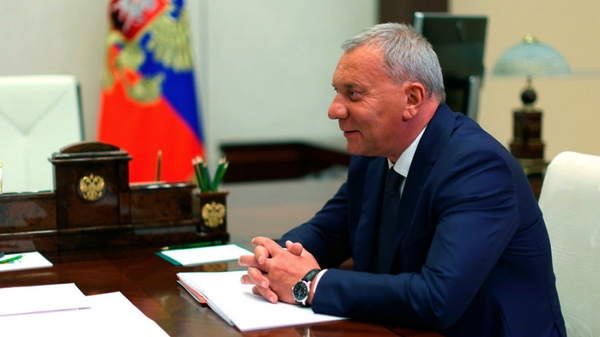The more things change…by Bill Barry
|
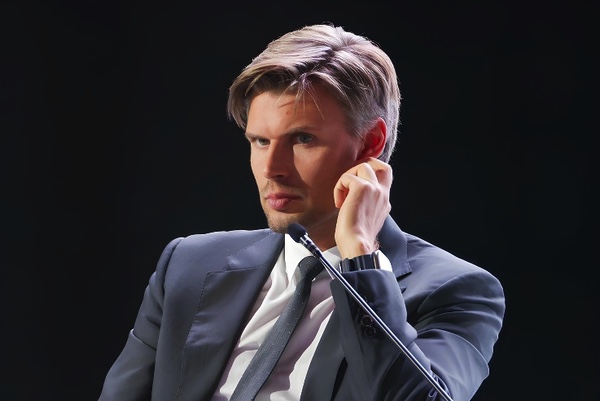 Dmitry Bakanov (Source: Transport.gov.ru) |
The failure of Russia’s first science mission to the Moon since 1976, the much-anticipated Luna 25 probe in August 2023, may have been the most embarrassing incident on Borisov’s watch, but it was only one of many.[2] Under Borisov, like his predecessors, Roscosmos has continued to face charges of corruption, particularly in relation to major construction projects. This includes the on-going development of the Vostochny Cosmodrome in eastern Russia, and the new Moscow headquarters for Roscosmos – which features the 47-story National Space Center tower. Both projects are far behind schedule, suffering cost overruns, and have repeatedly been investigated for a variety of legal/financial irregularities. Although Roscosmos has not suffered a launch failure since 2018, the rate of space launches has been anemic for the last decade. Soviet/Russian space launch rates haven’t been this low since 1961.[3]
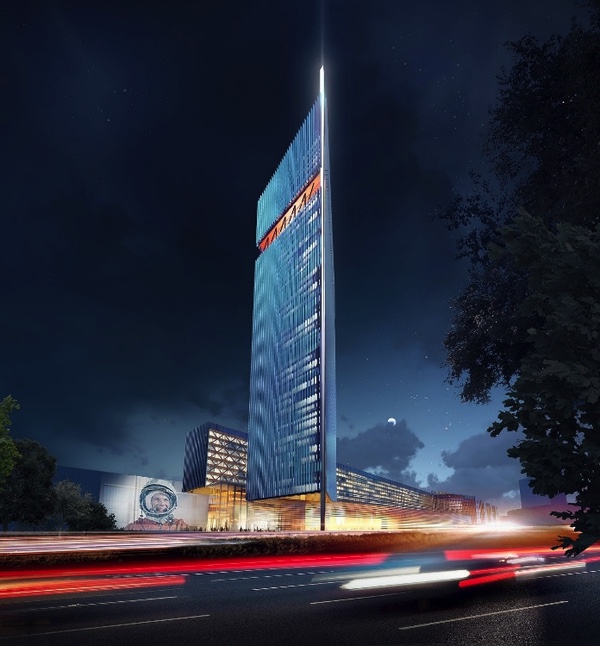 Artist’s depiction of the Russian National Space Center Tower (Source: Mos.ru) |
Perhaps more telling than the launch rate is the fact that the bulk of Russian launches continue to be conducted on the Soyuz launch vehicle. Fifteen of the 17 Russian launches in 2024 were on versions of the Soyuz. Although much improved over the years, the Soyuz launch vehicle is a derivative of the venerable R-7, the rocket used to launch Sputnik in 1957. Last December 25th, Russia celebrated the 2,000th launch of the R-7 family of vehicles.[4] This is an impressive record, but it is also a revealing statistic about their limited progress in launch vehicle development over the last 60+ years. The long-promised deployment of modernized launch vehicles (and spacecraft) continues to slip to the right. The flagship of new launch vehicles is the Angara family of rockets. This project was begun in 1992 to create an all-Russian booster that would eliminate dependence on Ukrainian rocket makers and the Baikonur Cosmodrome in Kazakstan. However, the first launch of the light version (Angara 1.2) didn’t happen until July 2014. Test of the heavy-lift Angara A5 (a replacement for the Proton launch vehicle) came just six months later. But, after 11 years, there have been a total of just nine Angara launches. The two non-Soyuz launches last year were an Angara 1.2 and an Angara A5. While there continues to be much talk about other launch vehicles and assorted new designs using cutting edge propellants or featuring SpaceX-style reusability, there has been little visible progress.
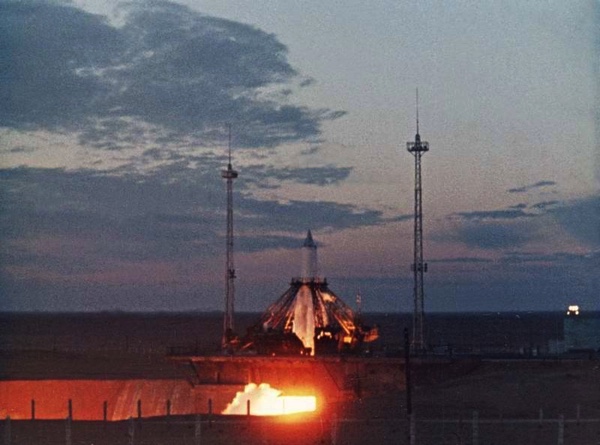 Above: Launch of Sputnik, 4 October 1957 (Source: NASA) Below: Launch of Resurs-P No. 5, 25 December 2024 (Source: Roscosmos) 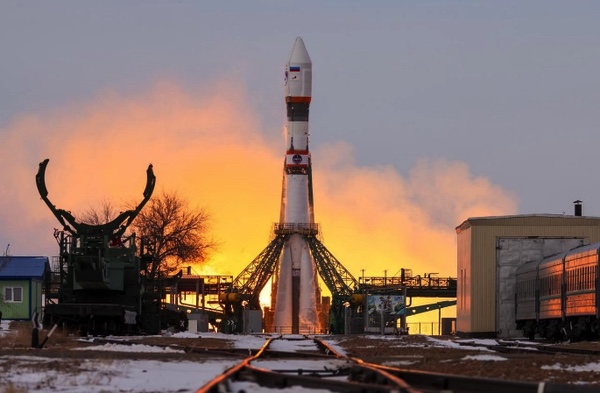 |
Given the rather sad recent record for the once mighty Soviet space program, you may wonder how Borisov lasted as long as he did. But it was widely recognized that he had done a good job under very difficult circumstances. His real challenge was dealing with the sanctions imposed on Russia following the second invasion of Ukraine in 2022, and the evaporation of the financial lifeline from NASA for International Space Station support in October 2020. Russian officials continue to tout the Kremlin talking points that claim Western sanctions have actually strengthened their economy. However, the fact is that the sanctions have been having a powerful effect, especially since 2022, including in the space sector.
In particular, Russian satellite production has been crippled by the lack of access to Western electronic components due to the sanctions. A long-standing weakness, the Russian electronics industry has been hard-pressed to develop and produce domestic replacements for the components they can no longer legally acquire from the West. Last May the state-owned Rostec defense conglomerate announced that the Express-AMU4 satellite would be the first Russian satellite made with entirely domestic components.[5] This satellite is predicted to be completed in 2026.
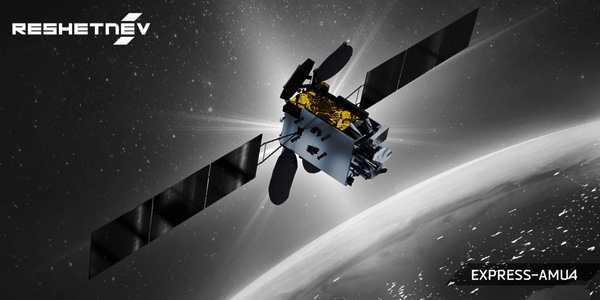 Artist’s conception of Express-AMU4 (Source: www.reshetnev.com) |
After attacking Ukraine again in early 2022, many commercial customers for Russian launches cancelled their contracts. This left Roscosmos in the awkward position of having many launch vehicles prepared, but unable to come up with payloads for them. In October 2023, Roscosmos head Borisov found himself explaining on Russian television that the total production capability of Russia is only 40 satellites per year.[6] Russian President Putin was quick to demand that Russia move to serial production of satellites and Borisov responded with a plan that is supposed to ramp up satellite production to 400 per year by 2030.[7]
The Russian civil space program had been critically dependent on financial support from the United States since the collapse of the Soviet Union. Initially rationalized in the West as an investment that would reduce International Space Station costs and prevent proliferation of missile technology by unemployed Russian engineers, temporary US financial support quickly became an expectation. Even after the Russian economy found itself awash in oil revenues in the early 2000s, Roscosmos officials pled poverty and insisted on renegotiation of financial arrangements with NASA at every turn.[8]
| The Russian civil space program had been critically dependent on financial support from the United States since the collapse of the Soviet Union. Even after the Russian economy found itself awash in oil revenues in the early 2000s, Roscosmos officials pled poverty and insisted on renegotiation of financial arrangements with NASA at every turn. |
Under President Putin, funding flowed into reconstituting the GLONASS satellite navigation constellation and numerous new military space and missile projects, but the civil space program was expected to support itself from “off-budget” sources. The primary source of such revenues under Putin was cooperative agreements, which entailed international partners effectively paying Russia to “cooperate” on various projects. While there were quite a few partners willing to pay for Russian space services, it was NASA’s big budget and devotion to the International Space Station (ISS) partnership that made them the primary source of funding from “international cooperation.” The 2002 US decision to rely on Russia for ISS crew transportation, rather than build a US crew return vehicle, was a godsend for Roscosmos.
As the political relationship soured, especially after the annexation of Crimea in 2014, Roscosmos could continue to raise the price for Soyuz seats while its leader Dmitry Rogozin continued to bite the hand that fed him. Whether Russian leaders were too wedded to the cash flow (and the opportunities for embezzlement) or simply underestimated the capabilities of US industry, Roscosmos appeared to be unprepared when the SpaceX Crew Demo-2 mission succeeded in the summer of 2020. The $90 million Russia received for the launch of astronaut Kate Rubins on Soyuz MS-17 in October 2020 would be the last of the easy money.[9] Rogozin didn’t last long after that, and Yuri Borisov was brought in to fix the problems. The fact that Roscosmos continued to function despite the loss of NASA funds and the escalation of sanctions in 2022, is a testament to Borisov’s focus on the financial bottom-line and his managerial skill.
His successor, the 39-year-old Dmitry Bakanov, has big shoes to fill. Although 31 years younger than his predecessor, Bakanov has enjoyed a meteoric rise through his short career. While working as an auditor at several banks he completed his master’s degree in economics in 2007. In 2008, he joined OAO Sitronics, a Russian microelectronics company, where he quickly moved from auditor to head of procurement. Three years later he was appointed president of the Gonets company. The Gonets satellite constellation provides secure store-and-dump communications. These satellites are a derivative of the military Strela communication satellites and Gonets services have been in high demand during the “Special Military Operation” in Ukraine.[10] In 2016, Bakanov was promoted to director general of Gonets.
In 2019, Bakanov received another promotion, this time into government service as the director of the Digital Transformation Department of the Russian Ministry of Transportation. Three years later he was promoted to Deputy Minister of Transportation. In the publicly released transcript of his March 31 meeting with President Putin, Bakanov’s work at Gonets was cited as the reason for his promotion to Director General of Roscosmos.[11] In addition to his experience in government and the space industry Bakanov comes with the cachet of a deep family connection to the space program. His father was a military engineer working at Baikonur, when Dmitry was born there in 1985. This was another point highlighted by President Putin in his public chat with Bakanov in March.
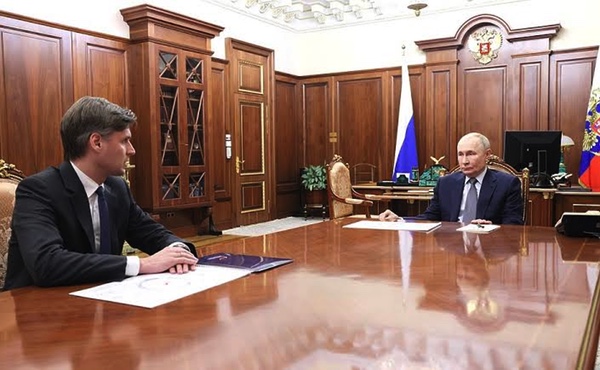 Dmitry Bakanov (L) meets with President Putin (R) on 31 March 2025. (Source: Kremlin.ru) |
Leadership changes ripple through any organization and there have been plenty of them following Bakanov’s promotion to Roscosmos. Interestingly, Yuri Borisov didn’t simply retire to his dacha, but a dozen days after being fired was appointed as the special Presidential Representative for International Space Cooperation.[12] This was a position that had been held for several years by legendary cosmonaut Sergei Konstantinovich Krikalev. On March 24, it was announced that Krikalev was being appointed as the Deputy Director General of Roscosmos for Manned and Automated Complexes.[13]
Over the coming weeks there were several other changes in senior positions at Roscosmos and the appointment of new temporary heads of several major organizations under Roscosmos, including prime civil space company RSC Energia. During the first week of May, Bakanov made his first official visits to three major organizations now under his command: the Khrunichev State Space Research and Production Center, the Central Research Institute for Mechanical Engineering (TsNIMash), and NPO Lavochkin. In addition to briefings and tours of the facilities, Bakanov also took the opportunity to “introduce” the new leaders that he had appointed to each of these organizations.[14]
| Sometimes called “Putin’s Trump-Whisperer,” Dmitriev is at the forefront of re-opening US-Russian relations this year. |
The changes at Roscosmos are significant, but for the US there has been another development that may be of more importance. The involvement of the CEO of the Russian Direct Investment Fund (RDIF), Kirill Alexandrovich Dmitriev, in space policy is both new and concerning. On March 18, during a speech at the Russian Union of Industrialists and Entrepreneurs, Dmitriev announced that he planned to meet with SpaceX CEO Elon Musk to discuss space cooperation with the US: “Our vision for cooperation with Musk goes beyond just Mars – it’s about leveraging the strong expertise within Roscosmos and Rosatom, which could contribute to making a Mars mission more efficient and safer.”[15] Rosatom, the Russian state nuclear corporation (whose senior officials were sanctioned by the Department of State in January) may be capable of supplying nuclear power generators for an outpost on Mars. Russia has signed an agreement with China to provide such a system to the International Lunar Research Station.[16] Rosatom has also been working on nuclear-powered plasma rocket engines that could speed up a trip to the Red Planet. In addition to specific suggestions about ways to cooperate, Dmitriev also made a point of stroking Elon Musk’s ego. During his March 18 speech, Dmitriev called Musk “…a unique leader committed to advancing humanity as a whole…(and)…one of the greatest leaders of our time.”[17]
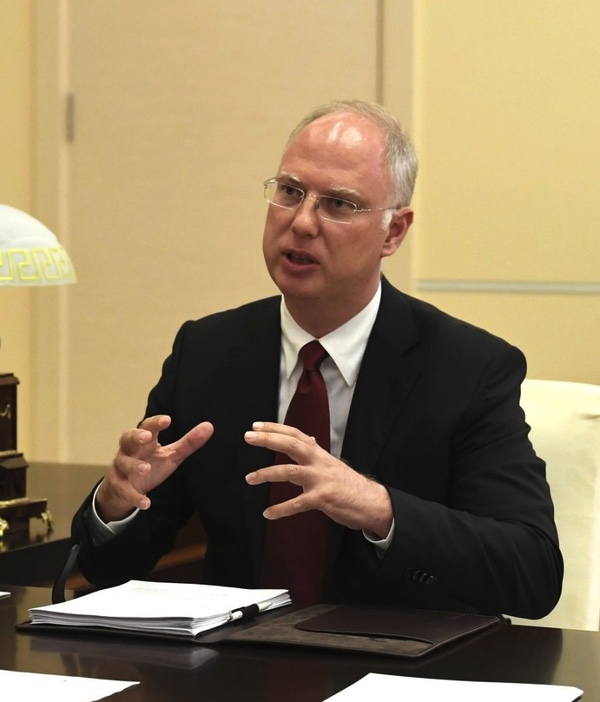 Kirill Dmitriev in a 2020 meeting with President Putin (Source: Kremlin.ru) |
Dmitriev has been CEO of RDIF since its creation in 2011. Both the RDIF and Dmitriev were sanctioned by the US Department of the Treasury in February 2022 following the second invasion of Ukraine. According to the Treasury press release, “While officially a sovereign wealth fund, RDIF is widely considered a slush fund for President Vladimir Putin and is emblematic of Russia’s broader kleptocracy.”[18]
Born in Kiev in 1975, Dmitriev came to the US as an exchange student in 1989 with limited English language skills, but finished a bachelor’s degree at Stanford and then an MBA at Harvard. He worked as an investment banker and consultant at Goldman Sachs and other companies in the West, prior to moving to Moscow in 2000. It isn’t clear howå Dmitriev came to then-Prime Minister Putin’s attention in 2011, but the Treasury Department sanction press release mentions a connection to Katerina Vladimirovna Tikhonova, Putin’s younger daughter. Dmitriev’s wife, Natalia Valerievna Popova, is reportedly a long-standing friend of Tikhonova and works as her deputy at the Innopraktika Foundation.[19] According to former FBI Director Robert Mueller’s investigation into Russian interference in the 2016 Presidential election, Dmitriev was one of several Kremlin representatives that made contact with the Trump team immediately after that election. Dmitriev reportedly told representatives of the incoming administration that “he had been tasked by Putin to develop and execute a reconciliation plan between the United States and Russia.”[20]
Sometimes called “Putin’s Trump-Whisperer,” Dmitriev is at the forefront of re-opening US-Russian relations this year.[21] On February 23, 2025, Dmitriev was named “Special Presidential Envoy on Foreign Investment and Economic Cooperation.” This came a week after Dmitriev had been part of the small Russian delegation meeting with Secretary of State Marco Rubio and Special Envoy Steve Witkoff in Saudi Arabia on February 18. In late March, Dmitriev continued actively courting Musk on social media. Noting that he had already had a conversation with new Roscosmos Director Bakanov on expanding cooperation with NASA, Dmitriev has repeatedly made the point that 2025 is the 50th anniversary of the joint Apollo-Soyuz mission. In a post on Musk’s social media site X, Dmitriev said “Will 2029 be the year of a joint U.S.-Russian mission to Mars, Elon Musk?”[221] In other posts he parroted criticism of President Biden for refusing help in getting the supposedly “stranded” Starliner astronauts back from the International Space Station.[23] It is worth noting that X is blocked in Russia, but Bakanov reportedly opened an account on the service this spring.[24]
In early April, the State Department temporarily lifted the sanctions imposed on Dmitriev so that he could come to Washington, DC, for meetings with Trump Administration officials. He was the first senior Russian official to visit the US since the February 2022 invasion of Ukraine. In addition to his official meetings, Dmitriev made the news media rounds during his stay in Washington, appearing on both Fox News and CNN. It isn’t clear if space cooperation was included in any of Dmitriev’s meetings in Washington, but the next week he continued to highlight US-Russian space cooperation on his social media accounts. Following the launch of Soyuz MS-27 to the ISS (with NASA astronaut Jonny Kim aboard) on April 8, Dmitriev noted “Russian and U.S. cooperation in the space industry continues today.”[25] He again highlighted that the launch was the continuation of an enduring relationship that dates to 1975.[26]
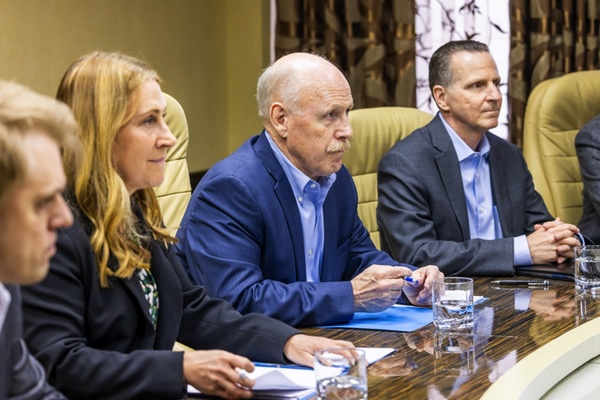 NASA Associate Administrator Ken Bowersox (C) in a meeting with Roskosmos General Director Bakanov at Baikonur Cosmodrome on 7 April 2025 (Source: Roscosmos) |
The day before the launch of Soyuz MS-27, the new head of Roscosmos met with NASA Associate Administrator Ken Bowersox at the Baikonur Cosmodrome. Bowersox was the senior NASA official at the launch. As has generally been the case since 2022, NASA press reports made no mention of the meeting with the head of Roscosmos. However, numerous Russian press sources covered the meeting. According to the Russian reports, Bowersox and Bakanov discussed cooperation on the ISS, launches from the Baiterek facility under construction at Baikonur, and “plans to commemorate the upcoming Soyuz-Apollo anniversary.”[27] In early May, Roscosmos Director General Bakanov announced that “…we’ll be speaking with [NASA Administrator nominee] Jared Isaacman soon.”[28]
| Will playing up the supposed advantages of their nuclear industry and launching a charm offensive on Musk work to get Russia the coveted position of integral partner in whatever future space exploration plans come out of the Trump Administration? Given the torrent of Russian press coverage on the topic, it seems clear that this is a high priority for Putin. |
Throughout April, Russian leaders continued to emphasize the continuity of space cooperation with the US and continued to appeal to Musk’s vanity. In response to a NASA post on X that briefly mentioned the anniversary of the first human spaceflight by Yuri Gagarin on April 12, Dmitriev responded with “NASA celebrating Gagarin. Cooperation will prevail.”[29] Shortly thereafter, Russian President Putin picked up the theme in comments to Russian university students that were widely reported in the Russian state press. Noting that cooperation first started in 1975 with the Apollo-Soyuz docking, Putin said that “This cooperation does not stop. It cannot stop, because so many countries are interested. Especially since we were and still are leaders in many areas. So, we are of interest to our partners.”[30] Putin also picked up on the potential for Rosatom involvement by claiming that plasma propulsion “…is our competitive advantage.”[31] While talking with the students Putin also paid the ultimate compliment to Elon Musk by comparing him to Soviet Chief Designer Sergey Korolev, the hero of early Soviet space successes.
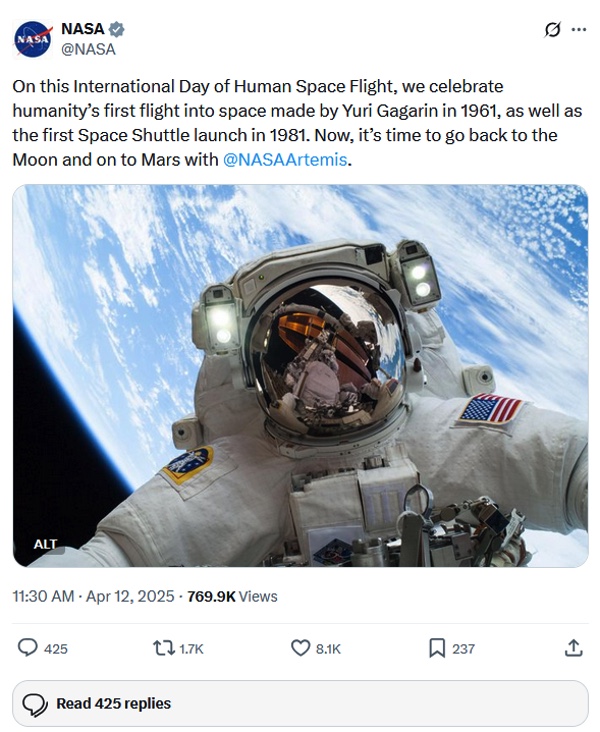 NASA Social Media Post, 12 April 2025 (Source: NASA) |
Will playing up the supposed advantages of their nuclear industry and launching a charm offensive on Musk work to get Russia the coveted position of integral partner in whatever future space exploration plans come out of the Trump Administration? Ironically, it may be hard to tell from US sources. But, given the torrent of Russian press coverage on the topic, it seems clear that this is a high priority for Putin. It is telling that when Trump’s representative Steve Witkoff met with Putin in the Kremlin on April 25, the Russian president was accompanied by just two advisors. One of them was Kirill Dmitriev. It seems likely that we’ll see a continued push from Russia for joint celebrations of the 50th anniversary of Apollo-Soyuz in July, as a way to prime the pump on future “cooperation” in space. The US government would be wise to consider the history of the last 35 years of space partnership with Russia before making any commitments with the new leadership of the Russian space program.
Endnotes
- Peskov linked Borisov’s dismissal to the need for rotation at Roscosmos, Izvestia, 6 February 2025.
- It had been expected that Luna 25 would finally give post-Soviet Russia a robotic space mission success. Their last, fully successful planetary mission was the Vega 2 probe that visited Venus and Comet Halley. It ended its mission in 1987.
- Eric Berger, Facing “financial crisis,” Russia on pace for lowest launch total in 6 decades, Ars Technica, 15 August 2024.
- Rita Tityanechko, Two thousand launches: the history of launches of the legendary family of R-7 rockets, ProKosmos.ru, 25 December 2024. (In Russian)
- First Russian satellite with import substitution to be launched in December 2026, TASS, 3 October 2024.
- Roscosmos faces grandiose task to start serial production of satellites – CEO, TASS, 27 October 2023.
- The President of Russia visited RSC Energia, where he held a meeting on the development of the space industry, Novosti Kosmonavtiki, 26 October 2023. (In Russian) As a point of comparison, SpaceX has already launched over 8,000 of its own Starlink satellites since 2018.
- This observation is based on my personal experience working on the Russia Team at what was then known as the Office of External Relations at NASA Headquarters from 2001 to 2010.
- Jeff Foust, The limits of space cooperation between the U.S. and Russia, SpaceNews, 22 October 2020.
- Russia’s Gonets satellite system in high demand for special military operation – official, TASS, 5 June 2024.
- Meeting with Director General of Roscosmos State Corporation Dmitry Bakanov, Kremlin.ru, 31 March 2025.
- Putin appoints ex-space agency chief representative for space cooperation, Reuters, 18 February 2025. Update: on May 22 Krikalev was reappointed as Special Representative for Space Cooperation.
- Krikalev appointed deputy head of Roscosmos for manned, automated complexes, TASS, 24 March 2025.
- Heading for Angara: Highlights from Bakanov’s visit to three key Roscosmos enterprises, Prokosmos.ru, 6 May 2025. (In Russian)
- Putin Envoy Dmitriev Says He Will Hold Talks With Musk About Mars Exploration, The Moscow Times, 18 March 2025.
- The International Lunar Research Station is a planned lunar base project. Although Russia claims to have a leadership role in the project, they appear to be a junior partner to China.
- Putin Envoy Dmitriev Says He Will Hold Talks With Musk About Mars Exploration, The Moscow Times, 18 March 2025.
- Treasury Prohibits Transactions with Central Bank of Russia and Imposes Sanctions on Key Sources of Russia’s Wealth, US Department of the Treasury, 28 February 2022.
- Kirill Dmitriev, Wikipedia entry
- Report On The Investigation Into Russian Election Interference In The 2016 Presidential Election, redacted version posted by the U.S. Department of Justice, p. 157.
- Martin Fornusek, Who is Kirill Dmitriev, Putin’s Trump-whisperer, The Kyiv Independent, 4 April 2025.
- Karolina Zulkarnaeva, Dmitry Bakanov: Without Russia, it is impossible to fly to other planets, Prokosmos.ru, 24 March 2025. (In Russian)
- Ibid.
- Anastasia Tenisheva, Kirill Dimitriev: The Putin Investment Envoy Navigating Peace Talks and Backchannel Diplomacy, The Moscow Times, 7 April 2025.
- Russia takes an American astronaut to the space station, Reuters, 8 April 2025. Since October 2020, NASA astronauts have continued to fly on Soyuz, and Russian cosmonauts on SpaceX Dragons, under a no exchange of funds barter agreement.
- Ibid. It is worth noting that formal U.S. – Soviet cooperation in space actually dates to an agreement signed in 1962, a decade before the agreement was signed that led to the Apollo-Soyuz mission flown in 1975.
- Roscosmos chief, NASA official discuss launches from Baiterek, TASS 7 April 2025. Baiterek is a joint Russian-Kazakh project involving conversion of an unused launch site. Russian officials have been trying to get NASA to invest in this project since the early 2000s.
- Head of Roscosmos announces upcoming talks with NASA Head candidate, TASS, 9 May 2025.
- Russian Direct Investment Fund chief convinced Russia-US space cooperation will prevail, TASS, 13 April 2025.
- Putin says many countries eager to cooperate with Russia in space industry, TASS, 16 April 2025.
- Russia attractive for international partners in space exploration, says Putin, TASS, 16 April 2025.
Note: we are now moderating comments. There will be a delay in posting comments and no guarantee that all submitted comments will be posted.
